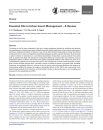Bibliografie
Attraction or repelling effects of commercial plant essential oils on the synanthropic Cheiracanthium mildei (Araneae: Cheiracanthiidae) 2022
- Autoři
- RNDr. Jiří Skuhrovec, Ph.D., RNDr. Milan Řezáč, Ph.D., Nela Gloríková
The resilience of weed seedbank regulation by carabid beetles, at continental scales, to alternative prey. 2020
- Autoři
- RNDr. Jiří Skuhrovec, Ph.D., RNDr. Milan Řezáč, Ph.D., Pavel Saska
- Abstrakt
- Carabids are generalist predators that contribute to the agricultural ecosystem service of seedbank regulation via weed seed predation. To facilitate adoption of this ecosystem services by farmers, knowledge of weed seed predation and the resilience of seedbank regulation with co-varying availability of alternative prey is crucial. Using assessments of the seedbank and predation on seed cards in 57 cereal fields across Europe, we demonstrate a regulatory effect on the soil seedbank, at a continental scale, by groups formed of omnivore, seed-eating (granivore + omnivore) and all species of carabids just prior to the crop-harvest. Regulation was associated with a positive relationship between the activity-density of carabids and seed predation, as measured on seed cards. We found that per capita seed consumption on the cards co-varied negatively with the biomass of alternative prey, i.e. Aphididae, Collembola and total alternative prey biomass. Our results underline the importance of weed seedbank regulation by carabids, across geographically significant scales, and indicate that the effectiveness of this biocontrol may depend on the availability of alternative prey that disrupt the weed seed predation.
Impact of an invasive tree on arthropod assemblages in woodlots isolated within an intensive agricultural landscape 2019
- Autoři
- RNDr. Jiří Skuhrovec, Ph.D., RNDr. Karel Tajovský, CSc., RNDr. Milan Řezáč, Ph.D., Pavel Marhoul, Pavel Saska
Arthropod fauna recorded in flowers of apomictic Taraxacum section Ruderalia. 2016
- Autoři
- RNDr. Jiří Skuhrovec, Ph.D., Josef Bezděk, prof. Mgr. Stanislav Pekár, Ph.D.
- Abstrakt
- Flowers of dicotyledonous plants host communities of arthropod species. We studied the community associated with dandelion (Taraxacum section Ruderalia), a complex of apomictic micro-species abundant in central Europe. Identifi cation of microspecies in the fi eld was impracticable. These plants produce an abundance of fl owers that host arthropod communities that are not yet fully documented. We investigated species occurrence, its diurnal and seasonal variation and some of the factors that determine the abundance of the dominant species. Insect and spiders were collected from 2010 to 2012 at a locality in Prague. Whole capitula were harvested at weekly intervals and resident arthropods were identifi ed. Diurnal variation in insect presence and the effect of pollen and microclimate on some of the species were also examined. The insect community (> 200 species) consisted mainly of species of Hymenoptera (86 spp.), Coleoptera (56 spp.), Diptera (46 spp.) and Heteroptera (23 spp.). The most abundant were Thysanoptera (2 spp.). Pollen eaters/collectors and nectar feeders dominated over predators and occasional visitors. From April to mid-August, the insect community was dominated by Coleoptera, and later by Diptera and Hymenoptera. Except for Meligethes spp. and species breeding in the capitula, the insects occupied fl owers during the daytime when the fl owers were open (10–12 h in spring and only 2–4 h in late summer). The presence of Meligethes spp. in particular fl owers was associated with the presence of pollen; the occurrence of Byturus ochraceus with pollen and fl ower temperature. Although pollination is not necessary, dandelion plants produce both nectar and pollen. The community of arthropods that visit dandelion fl owers is rich despite their being ephemeral. The composition of local faunas of fl ower visitors, presence of fl oral rewards and fl ower microclimate are important factors determining the composition of the fl ower community.
Technical reclamations are wasting the conservation potential of post-mining sites. A case study of black coal spoil dumps. 2012
- Autoři
- Mgr. Igor Malenovský, Ph.D., RNDr. Jiří Skuhrovec, Ph.D., Lukáš Spitzer, RNDr. Robert Tropek, Ph.D.






